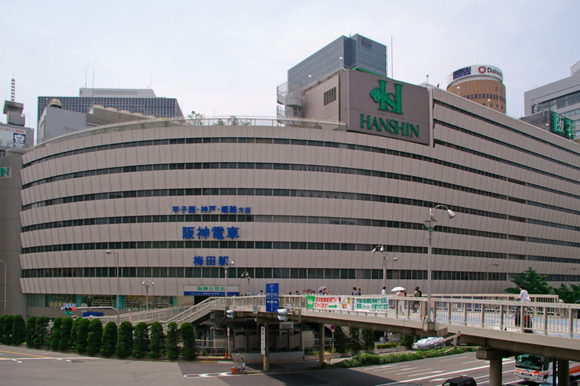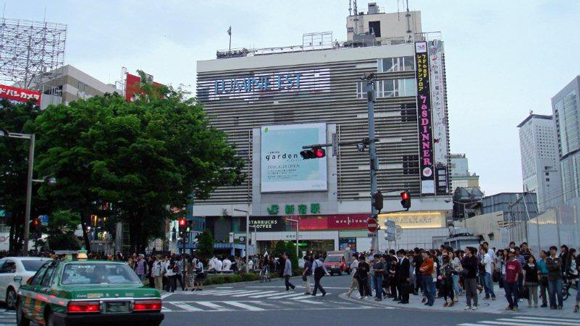A couple of days ago this little graph surfaced online displaying some interesting statistics. It’s a bar chart of the busiest train stations in the world, measured by the number of people who pass through them each year.
Perhaps coming as no surprise to those who have experienced its mind-numbingly complex transport complexes, Japan tops the list. What is surprising is the degree to which Japan dominates this list, with all but six stations residing here, and about half of them in the Tokyo area alone.
The following are the five busiest train stations in the world, although you woudn’t know it’s an international ranking just by looking at it.
#5 Yokohama Station (Kanagawa, Japan) – Approx. 760,000,000 people per year

Located in Yokohama city near the border of Kanagawa Prefecture and Tokyo, this was one one of Japan’s first great stations. A few moves and destruction caused by the Great Kanto Earthquake left it in its current location now.
The station is the nucleus to a vertically and horizontally sprawling commercial area hosting most if not all of Japan’s major chain stores like Takashimaya and Yodobashi Camera.
#4 Umeda Station (Osaka, Japan) – Approx. 820,000,000

As a resident of Osaka, this station is my own slice of nightmare. Every time I go there it tends to end with me huddled in a corner crying. This multilevel serpentine station hosts ever running rivers of people bumping into one another walking in every direction at the same time.
Remember one of those typical video game levels where you constantly walk through one door only to find yourself in the same room until you throw your controller at your little brother? It’s kind of like that.
But we’ve only just begun.
#3 Ikebukuro Station (Tokyo, Japan) – Approx. 910,000,000
Located in the heart of Tokyo, it’s no wonder Ikebukuro station is so heavily used. As a result it’s home to a bevy of attractions like gourmet hotdogs, penguins on waterslides, alleged teenage girl viewing clubs, and the occasional Cornman sighting.
Ikebukuro Station feeds lines into Shinjuku Station along with…
#2 Shibuya Station (Tokyo, Japan) – Approx. 1,090,000,000

Also in the center of Tokyo, Shibuya station has a kind of nice atmosphere to it that can almost distract an agoraphobe from the hordes of commuters passing through. The station also features large, eye-catching artwork from Taro Okamoto.
There’s also a statue to Hachiko near one of the exits. Hachiko was the dog immortalized in Japanese and (to a lesser extent) American movies as the dog who faithfully waited for his dead master outside of Shibuya station for nine years.
Shibuya and Ikebukuro Stations stand on either side of Shinjuku Station. You can probably see where this is going.
#1 Shinjuku Station (Tokyo, Japan) – Approx. 1,260,000,000

Many people are often in awe of Shinjuku Station’s massive size or complain about its complexity, built to handle over one million daily commuters. I don’t know what their problem is. Here’s a perfectly simple map of the place:

Actually this is just the JR-East railway section of the station which accommodates four other train operators. So multiply that map by about three and you’ll have the rough make-up of the basic station. Throw in all the other shopping and entertainment facilities often found around train stations and you have a labyrinth that’d make David Bowie give a whistling admiration.
The above graph leaves little in the way of concrete details such as the date of the information, so it’s hard to gauge how accurate the data is, but checking a few of the station’s statistics it seems to check out.
For example, India’s Chhatrapati Shivaji Terminus reportedly handles 3,000,000 people a day but it’s uncertain.
Also, if the rapid development of China continues unabated we may soon see more of their stations popping up in the rankings. So, you may want to take these figures with a grain of salt.
Here’s the full list of 51 stations. If you don’t live in Japan there’s a slight chance your country is on there.
1 Shinjuku (Tokyo, Japan)
2 Shibuya (Tokyo, Japan)
3 Ikebukuro (Tokyo, Japan)
4 Umeda (Osaka, Japan)
5 Yokohama (Kanagawa, Japan)
6 Kita-Senju (Tokyo, Japan)
7 Nagoya (Aichi, Japan)
8 Tokyo (Tokyo, Japan)
9 Shinagawa (Tokyo, Japan)
10 Takadanobaba (Tokyo, Japan)
11 Namba (Osaka, Japan)
12 Shinbashi (Tokyo, Japan)
13 Tennouji (Osaka, Japan)
14 Akihabara (Tokyo, Japan)
15 Kyoto (Kyoto, Japan)
16 Sannomiya (Kobe, Japan)
17 Omiya (Saitama, Japan)
18 Yurakucho-Hibiya (Tokyo, Japan)
19 Nishi-Funabashi (Chiba, Japan)
20 Meguro (Tokyo, Japan)
21 Daimon-Hamamatsucho (Tokyo, Japan)
22 Ueno (Tokyo, Japan)
23 Oshiage (Tokyo, Japan)
24 Paris Nord (Paris, France)
25 Taipei Railway Station (Taipei,Taiwan)
26 Machida (Tokyo, Japan)
27 Gare de Chatelet (Paris, France)
28 Kawasaki (Kanagawa, Japan)
29 Roma Termini Railway Station (Rome, Italy)
30 Tamachi-Mita (Tokyo, Japan)
31 Kyobashi (Osaka, Japan)
32 Funabashi (Chiba, Japan)
33 Ayase (Tokyo, Japan)
34 Hamburg Central Station (Hamburg, Germany)
35 Yoyogi-Uehara (Tokyo, Japan)
36 Kamata (Kamata, Japan)
37 Gotanda (Tokyo, Japan)
38 Kichijoji (Tokyo, Japan)
39 Kaneyama (Aichi, Japan)
40 Musashikosugi (Kanagawa, Japan)
41 Fujisawa (Kanagawa, Japan)
42 Oimachi (Tokyo, Japan)
43 Nakano (Tokyo, Japan)
44 Tachikawa (Tokyo, Japan)
45 Iidabashi (Tokyo, Japan)
46 Kashiwa (Chiba, Japan)
47 Hakata (Fukuoka, Japan)
48 Tsuruhashi (Osaka, Japan)
49 Nishi-Nippori (Tokyo, Japan)
50 Nakameguro (Tokyo, Japan)
51 Zurich Main Station (Zurich, Switzerland)
More Countries Join the New List of 100 Busiest Train Stations, Japan Still Claims 82 of Them
Source: Himasoku (Japanese)


 More Countries Join the New List of 100 Busiest Train Stations, Japan Still Claims 82 of Them
More Countries Join the New List of 100 Busiest Train Stations, Japan Still Claims 82 of Them Tokyo starts massive renovation project for entrances to the world’s busiest train station
Tokyo starts massive renovation project for entrances to the world’s busiest train station Posters of SoraNews24 ace reporter Mr. Sato appear in one of Tokyo’s busiest train stations【Pics】
Posters of SoraNews24 ace reporter Mr. Sato appear in one of Tokyo’s busiest train stations【Pics】 Shitty Shinjuku – 30-meter streak of human turd spotted in Tokyo’s busiest train station
Shitty Shinjuku – 30-meter streak of human turd spotted in Tokyo’s busiest train station My Neighbour Totoro train jingles now playing at Tokorozawa Station【Videos】
My Neighbour Totoro train jingles now playing at Tokorozawa Station【Videos】 Cup Noodle tries an authentic Jiro-style ramen, but something’s not quite right
Cup Noodle tries an authentic Jiro-style ramen, but something’s not quite right We revisited Sweets Paradise after a decade to see if Japan’s dessert buffet still delivers
We revisited Sweets Paradise after a decade to see if Japan’s dessert buffet still delivers New Japanese menstrual product seeks to help women spot unidentified iron deficiencies
New Japanese menstrual product seeks to help women spot unidentified iron deficiencies Join the hordes of net users giggling at GIFs of sumo wrestlers performing comedic moves【Videos】
Join the hordes of net users giggling at GIFs of sumo wrestlers performing comedic moves【Videos】 This Kobe Beef croquette currently has a 35-year waitlist…So is it worth it?【Taste Test】
This Kobe Beef croquette currently has a 35-year waitlist…So is it worth it?【Taste Test】 New Pokémon blankets are part plushie cushion, part fluffy wrap, and all adorable【Photos】
New Pokémon blankets are part plushie cushion, part fluffy wrap, and all adorable【Photos】 The best Japanese cosplayers from Day 4 of Winter Comiket 2019【Photos】
The best Japanese cosplayers from Day 4 of Winter Comiket 2019【Photos】 Dragon Quest Slime toys appear at McDonald’s Japan in crossover with Grimace and pals【Video】
Dragon Quest Slime toys appear at McDonald’s Japan in crossover with Grimace and pals【Video】 Which Japanese convenience store sells the best pizzas?【Taste test】
Which Japanese convenience store sells the best pizzas?【Taste test】 7-Eleven Japan’s ramen-cooking robot whipped us up a bowl of noodles【Taste test】
7-Eleven Japan’s ramen-cooking robot whipped us up a bowl of noodles【Taste test】 Starbucks Japan ready to get Year of the Horse started with adorable drinkware and plushies【Pics】
Starbucks Japan ready to get Year of the Horse started with adorable drinkware and plushies【Pics】 7 great places to see Mt. Fuji from without having to climb it
7 great places to see Mt. Fuji from without having to climb it Cyberpunk anime meets traditional culture in Ghost in the Shell gold leaf Japanese changing screens
Cyberpunk anime meets traditional culture in Ghost in the Shell gold leaf Japanese changing screens Hayao Miyazaki says Happy New Year to Studio Ghibli fans with new art for Year of the Horse
Hayao Miyazaki says Happy New Year to Studio Ghibli fans with new art for Year of the Horse Hello Kitty Choco Egg figures are an adorable trip through three periods of Japanese pop culture【Pics】
Hello Kitty Choco Egg figures are an adorable trip through three periods of Japanese pop culture【Pics】 We found possibly the quietest Japanese-style hotel in Tokyo’s bustling Shinjuku district
We found possibly the quietest Japanese-style hotel in Tokyo’s bustling Shinjuku district Sumo Sanrio! Hello Kitty and pals team up with Japan Sumo Association for new merch【Pics】
Sumo Sanrio! Hello Kitty and pals team up with Japan Sumo Association for new merch【Pics】 Japan’s oldest largetooth sawfish in captivity back on display in Mie Prefecture
Japan’s oldest largetooth sawfish in captivity back on display in Mie Prefecture More Than a Capsule Stay: Why Solo Travelers Choose “global cabin Yokohama Chinatown”
More Than a Capsule Stay: Why Solo Travelers Choose “global cabin Yokohama Chinatown” 7-Eleven Japan starts new temporary luggage storage service in over 300 branches
7-Eleven Japan starts new temporary luggage storage service in over 300 branches Disillusionment at Tsukiji’s tourist-target prices led us to a great ramen restaurant in Tokyo
Disillusionment at Tsukiji’s tourist-target prices led us to a great ramen restaurant in Tokyo Starbucks teams up with 166-year-old Kyoto doll maker for Year of the Horse decorations【Photos】
Starbucks teams up with 166-year-old Kyoto doll maker for Year of the Horse decorations【Photos】 Tokyo considering law requiring more trash cans following litter increase in heavily touristed area
Tokyo considering law requiring more trash cans following litter increase in heavily touristed area Tokyo’s Tsukiji sushi neighborhood asks tour groups to stay away for the rest of the month
Tokyo’s Tsukiji sushi neighborhood asks tour groups to stay away for the rest of the month Tokyo event lets you travel back in time, for free, to celebrate 100 years since Showa era start
Tokyo event lets you travel back in time, for free, to celebrate 100 years since Showa era start Sanrio theme park in Japan announces plans to expand into a Sanrio resort
Sanrio theme park in Japan announces plans to expand into a Sanrio resort Japan may add Japanese language proficiency, lifestyle classes to permanent foreign resident requirements
Japan may add Japanese language proficiency, lifestyle classes to permanent foreign resident requirements Stamina-destroying “Paralysis Noodles” are Tokyo’s newest over-the-top ramen innovation
Stamina-destroying “Paralysis Noodles” are Tokyo’s newest over-the-top ramen innovation Survey asks foreign tourists what bothered them in Japan, more than half gave same answer
Survey asks foreign tourists what bothered them in Japan, more than half gave same answer Japan’s human washing machines will go on sale to general public, demos to be held in Tokyo
Japan’s human washing machines will go on sale to general public, demos to be held in Tokyo Japan’s deadliest food claims more victims, but why do people keep eating it for New Year’s?
Japan’s deadliest food claims more victims, but why do people keep eating it for New Year’s? We deeply regret going into this tunnel on our walk in the mountains of Japan
We deeply regret going into this tunnel on our walk in the mountains of Japan Studio Ghibli releases Kodama forest spirits from Princess Mononoke to light up your home
Studio Ghibli releases Kodama forest spirits from Princess Mononoke to light up your home Major Japanese hotel chain says reservations via overseas booking sites may not be valid
Major Japanese hotel chain says reservations via overseas booking sites may not be valid Put sesame oil in your coffee? Japanese maker says it’s the best way to start your day【Taste test】
Put sesame oil in your coffee? Japanese maker says it’s the best way to start your day【Taste test】 No more using real katana for tourism activities, Japan’s National Police Agency says
No more using real katana for tourism activities, Japan’s National Police Agency says Starbucks Japan reveals new sakura drinkware collection, inspired by evening cherry blossoms
Starbucks Japan reveals new sakura drinkware collection, inspired by evening cherry blossoms Updated cherry blossom forecast shows extra-long sakura season for Japan this year
Updated cherry blossom forecast shows extra-long sakura season for Japan this year One of the busiest stations in Tokyo is changing the name on its signs, but not necessarily to make it easier for people to find their way around.
One of the busiest stations in Tokyo is changing the name on its signs, but not necessarily to make it easier for people to find their way around. Navigate your way through Japan’s busiest train stations with Google Street View
Navigate your way through Japan’s busiest train stations with Google Street View Woman decides to go for a walk on the busiest train tracks at Shibuya Station【Video】
Woman decides to go for a walk on the busiest train tracks at Shibuya Station【Video】 Tokyo’s busiest train stations have a new, free, English-compatible navigation app
Tokyo’s busiest train stations have a new, free, English-compatible navigation app Tokyo’s busiest train line to be partially shut down this weekend as part of Shibuya renovations
Tokyo’s busiest train line to be partially shut down this weekend as part of Shibuya renovations New Welcome to Kanto Pasmo IC Card is the most kawaii way to ride trains on a trip to Japan
New Welcome to Kanto Pasmo IC Card is the most kawaii way to ride trains on a trip to Japan Man hangs himself outside of Japan’s busiest train station
Man hangs himself outside of Japan’s busiest train station Giant Chiikawa statues appear in one of Tokyo’s most confusing train stations【Photos】
Giant Chiikawa statues appear in one of Tokyo’s most confusing train stations【Photos】 New study ranks the most notorious Japanese train stations for perverts
New study ranks the most notorious Japanese train stations for perverts Woman in Tokyo gives birth onboard one of Japan’s busiest train lines
Woman in Tokyo gives birth onboard one of Japan’s busiest train lines Tokyo partially shut down busiest train line, 3,200 workers fought clock on platform project【Vid】
Tokyo partially shut down busiest train line, 3,200 workers fought clock on platform project【Vid】 We visit Kyushu’s oldest wooden train station building, get hit with a nostalgia overload
We visit Kyushu’s oldest wooden train station building, get hit with a nostalgia overload The Station Idol Latch! project gifts us with 30 male idols for 30 Yamanote Line stations
The Station Idol Latch! project gifts us with 30 male idols for 30 Yamanote Line stations
Leave a Reply